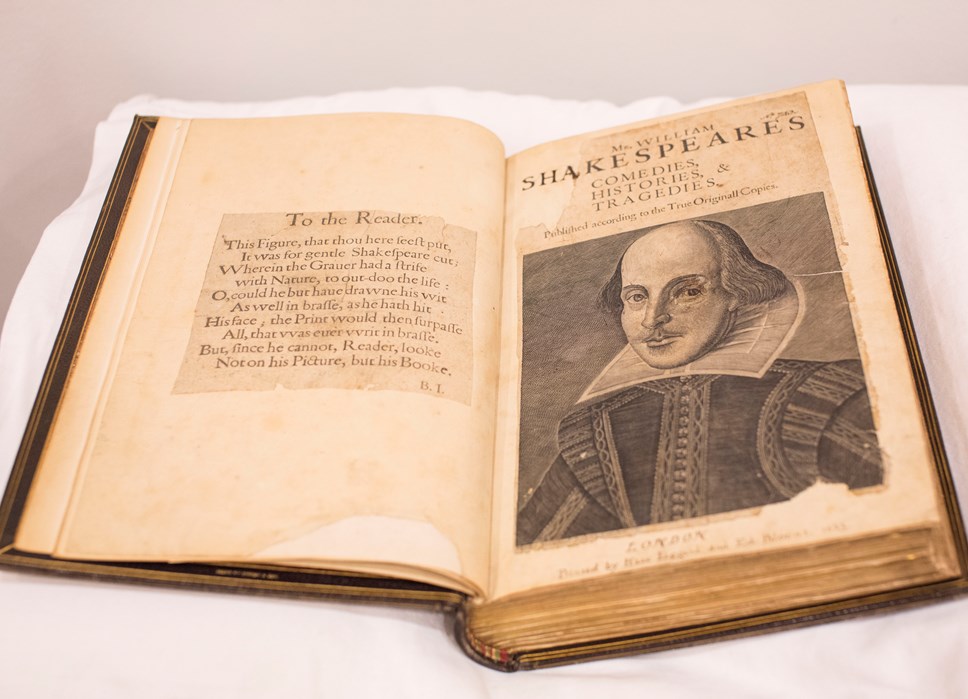
Shakespeare’s First Folio to go on display
The National Library of Scotland’s copy of Shakespeare’s First Folio will go on display from tomorrow (Saturday 16 September) in Edinburgh.
This year is the 400th anniversary of the First Folio, the first collected edition of Shakespeare’s plays.
The National Library’s First Folio display is the final in a series of displays in Scotland as part of the UK and Ireland Folio400 celebrations. It can be found in the ‘Treasures of the National Library of Scotland’ exhibition at George IV Bridge. There are only two other copies of the First Folio in publicly accessible collections in Scotland – held at the University of Glasgow and Mount Stuart Trust.
Only 18 of Shakespeare's plays appeared in print during his lifetime, and some of these were in corrupt or pirated editions. The First Folio collection contains 36 plays, 18 of which were published for the first time, thus saving such works as ‘The Tempest’ and ‘Macbeth’ from probable extinction.
The Scottish books are three different folios, in three very different collections, with three different stories to tell.
The National Library’s Head of Rare Books, Maps and Music, Helen Vincent said: “We’ve seen everyone from schoolchildren to actors to researchers fascinated by the First Folio and the stories it contains, so we’re looking forward to bringing it to a wide audience in our Treasures exhibition. It will be on display for the actual birthday of the book in November – the month it was first offered for sale in 1623. I’m sure the people who put such effort into producing this book would love to know that 400 years later, their dedication to preserving and sharing all of Shakespeare’s plays continues to have such a profound impact on culture in all its forms.”
Professor Adrian Streete, Head of English Literature at the University of Glasgow, said: “Today the First Folio is a literary and cultural monument, as several of those involved in collecting and printing Shakespeare’s plays four hundred years ago hoped it would be. Yet in 1623, the publishing of the First Folio was an expensive and risky undertaking. Shakespeare’s popularity was not then what it would become later.
“The story of how Mr. William Shakespeares Comedies, Histories, & Tragedies became the ‘First Folio’ is a long and complicated one, bound up with shifting ideas of literary prestige, the theatre, and national identity. But the First Folio remains a monument to the enduring power of literature to help us make sense of ourselves and others, and to imagine new and better worlds.”
The Mount Stuart Trust’s Librarian, Elizabeth Ingham said: “We are indebted to the people who edited, printed, and published the First Folio in 1623, who preserved the memory of Shakespeare and ensured the survival of his extraordinary plays for future generations. We were delighted to display the Bute Collection’s First Folio to celebrate the 400th publication anniversary, and we also shared the wonders of Shakespeare’s work with school groups and our visitors to Mount Stuart earlier this year.”
About 750 copies of the 1623 First Folio were printed. 235 are known to have survived with 50 copies still in the UK, 149 in USA and 36 in other corners of the world (nine of which are listed as ‘missing’).
The National Library of Scotland’s First Folio will go on display alongside a new selection of items, including:
- One of the Hyakumantō darani, or the One million pagodas and darani prayers, produced in Japan between 764 and 770. The earliest evidence of printing comes from 8th-century Japan and Korea, hundreds of years before it was practised in Europe.
- Burns’s Tam o’ Shanter, which he wrote in 1790 to accompany the entry for Alloway Kirk in Francis Grose’s ‘Antiquities of Scotland’ (1791). What began as a footnote in Grose’s book became one of Burns’s most popular works and made Tam an icon of Scottish culture. The poem’s dramatic narrative and vivid descriptions of witches and warlocks have inspired generations of artists.
- The earliest published regional map of ‘Lothian and Linlitquo’ by Joan Blaeu, with Edinburgh coloured in red in the centre. From Scotland’s first atlas presented a flattering, detailed and visually stunning view of the country in 49 maps with accompanying descriptions.
- Early works in astronomy. In 1543, Nicolaus Copernicus’s (1473–1543) publication, ‘On the Revolutions of the Celestial Spheres’ showed for the first time that the Sun, not the Earth, is the centre of our solar system.
‘Treasures of the National Library of Scotland’ is open Monday to Saturday at George IV Bridge, Edinburgh. Entry is free. > https://www.nls.uk/treasures/visit/
Contact Information
Notes to editors
Folio400
Folio400 aims to arrange, encourage and promote an array of shows to celebrate the 400th Birthday of The First Folio, the first printed edition of Shakespeare’s collected plays, in 2023. Folio Day, the 23 April 2023 – Shakespeare’s birthday – launched the Folio Season. A number of both institutional and private First Folio owners will make their copies available to be viewed by the public across the UK and Ireland including the three Scottish institutions.
For more info here – Folio 400 - Printing Shakespeare
National Library of Scotland
The National Library of Scotland is a major European research library and one of the world’s leading centres for the study of Scotland and the Scots – an information treasure trove for Scotland’s knowledge, history and culture.
Its collections are of international importance. Key formats include rare books, manuscripts, maps, photographs, music, films and official publications. The Library holds more than 30 million physical items dating back more than 1,000 years as well as a growing library of digital material.
The National Library’s copy of the First Folio has been in Scotland for at least 230 years – more than half its life. A Miss Clarke of Dunbar presented it to the Society of Antiquaries of Scotland in 1784 – its earlier history is unknown and there is no material clue in the book as it survives, although there is evidence that it has been well-read.
The First Folio first came to the National Library – then only nine years old – in 1934, first as a loan. It was gifted to the Library in 1949 along with other books from the Library of the Society of Antiquaries. It sits alongside the Library’s extensive collections of early modern drama, which include some Shakespeare quartos – early editions of single plays, mostly published before the First Folio. The Bute collection of early drama was acquired in 1956: as its name suggests, this came from the same collections as the Bute Folio at Mount Stuart.
Mount Stuart
Mount Stuart Trust is a Charitable Trust managed by a board of independent Trustees, which works to facilitate public interest, understanding and appreciation of the arts, architecture, and the rural environment. The Trust manages and maintains a series of assets across the Island of Bute, including Mount Stuart House and Gardens, which have been open to the public since 1995.
The Bute Collection is generously loaned to the Mount Stuart Trust and is one of the UK’s foremost private historic collections, dating from the 12th century to the present day. Collected by successive generations of the Crichton Stuart family, the Bute Collection consists of spectacular fine and decorative art, an internationally significant archive, and historic libraries comprised of over 27,000 books – including the Bute First Folio.
The Bute First Folio was owned by the actor, John Henderson (1747-1785), and given to the notable Shakespearean editor, Isaac Reed, by Henderson’s widow on 3 February 1786. It was acquired in the 19th century by the Crichton Stuart family, who gathered a remarkable collection of early modern plays over the course of several generations.
In 1896, the Bute First Folio formed part of the 3rd Marquess of Bute’s library at St John’s Lodge, London, which was inherited by his son, the 4th Marquess of Bute, in 1900. The 4th Marquess was a keen bibliophile and advocate of craftsmanship, who commissioned a fresh binding for the Folio from the bookbinder William Pender in 1931-32.
On the outbreak of war, the 4th Marquess’ books in London were moved to Scotland for safety, including the Bute First Folio which was relocated to Mount Stuart on the Isle of Bute. Today, the Bute First Folio continues to be cared for in the Bute Collection at Mount Stuart, where it is shared with school groups and visitors to Mount Stuart House and Gardens. Mount Stuart First Folio
Mount Stuart Trust displayed the Bute First Folio at Mount Stuart from 17 April – 3 May this year, and welcomed visiting school groups for activities throughout its display period. Private viewings of the Bute First Folio are still available to pre-book until October 2023. Find out more here: Plan your Visit to Mount Stuart – What’s On at Mount Stuart
The University of Glasgow
Founded in 1451, the University of Glasgow has an extensive range of rare and internationally important collections.
The University of Glasgow’s First Folio, held in the Library’s Archives & Special Collections, recently underwent conservation work. It is a complex ‘made up’ volume, formed from combining two or three different imperfect copies to create a whole. In common with most other surviving First Folios, the book shows considerable signs of wear and use, and many of its pages are stained and dirt engrained. This evidence of heavy use by previous owners can offer us historical insights into reading habits, and this copy is particularly important for its early annotations that were made by a reader who had evidently seen Shakespeare’s plays being acted contemporaneously.
The University’s First Folio went on display at the start of Folio 400 celebrations on the weekend of 22 and 23 April at The Hunterian Art Gallery. More here – University of Glasgow First Folio
Archives & Special Collections brings together an extensive range of rare, unique, and internationally important collections. The University has been collecting since it was founded in 1451.
The Hunterian opened its doors in 1807, making it Scotland’s oldest museum and giving it a unique place within Scotland’s cultural heritage. The Hunterian’s collections spanning arts, sciences and humanities.
